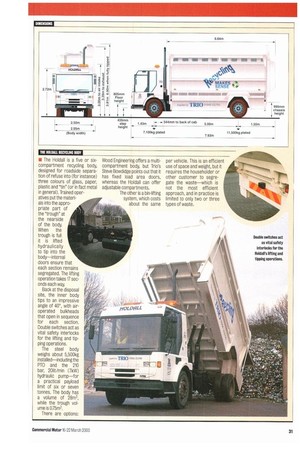THE HOLDALL RECYCLING BODY
Page 33

If you've noticed an error in this article please click here to report it so we can fix it.
• The Holdall is a five or sixcompartment recycling body, designed for roadside separation of refuse into (for instance) three colours of glass, paper, plastic and "tin" (or in fact metal in general). Trained oper atives put the materi als into the appro priate part of the "trough" at the nearside of the body.
When the trough is full it is lifted hydraulically to tip into the body—internal doors ensure that each section remains segregated. The lifting . operation takes 17 seconds each way.
Back at the disposal site, the inner body tips to an impressive angle of 400, with airoperated bulkheads that open in sequence for each section. Double switches act as vital safety interlocks for the lifting and tipping operations.
The steel body weighs about 5,500kg installed—including the PTO and the 210 bar, 201it/min (7kw) hydraulic pump—for a practical payload limit of six or seven tonnes. The body has a volume of 28m3, while the trough volume is 0.75m3.
There are options
Wood Engineering offers a multicompartment body, but Trio's Steve Bowdidge points out that it has fixed load area doors, whereas the Holdall can offer adjustable compartments.
The other is a bin-lifting system, which costs about the same per vehicle. This is an efficient use of space and weight, but it requires the householder or other customer to segregate the waste—which is not the most efficient approach, and in practice is limited to only two or three types of waste.
















































































































